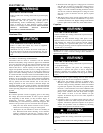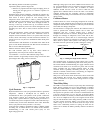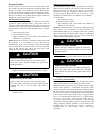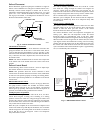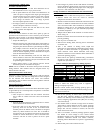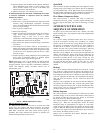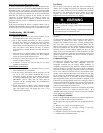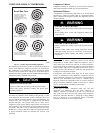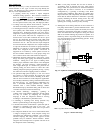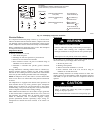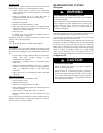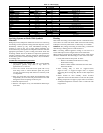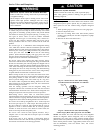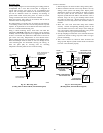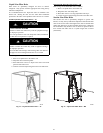
20
Noisy Compr
essor
Noise may be caused by a variety of internal and external factors.
Careful attention to the “type” of noise may help identify the
source. The following are some examples of abnormal conditions
that may create objectionable noise:
1. A gurgling sound may indicate a liquid refrigerant
floodback during operation. This could be confirmed if
there is no compressor
superheat. A compressor superheat
of “0” degrees would indicate liquid refrigerant returning to
the compressor. Most common reasons for floodback are:
loss of evaporator blower, dirty coils, and improper airflow.
2. A rattling noise may indicate loose hardware. Inspect all
unit hardware including the compressor grommets.
3. A straining (hard start) or vibration occurring at start up but
clears quickly after could indicate an off cycle refrigerant
migration issue. Refrigerant migration can occur when a
compressor is off and refrigerant vapor transfers from other
areas of the system, settles into the compressor as it is
attracted to the oil, and then condenses into the oil. Upon
start up, the compressor draws suction from within itself
first and lowers the boiling point of the refrigerant that is
entrained in the oil. This can cause the liquid refrigerant
and oil to boil into the compression area or liquid refrigerant
to wipe off oil films that are critical for proper lubrication.
Migration is worsened by greater temperature differentials
and/or extra refrigerant in the system. Prevention of
migration can be reduced by various options but some of
the more common remedies is to verify proper charge and
add a crankcase heater where this situation is suspected.
4. Operational vibration could indicate a charge issue. Verify
charge and ensure proper piping and structural penetration
insulation. Tubing that is too rigid to building rafters
without proper insulation could transfer noise throughout
the structure. On some occasions a sound dampener or
mass weight (RCD part no. 328209--751) placed on the
vibrating tubing has been known to reduce this noise.
Utilizing compressor split post grommets (see Fig. 12) may
also reduce this vibration if piping cannot be remedied.
5. An operational high pitch frequency or “waa waa” sound
that appears to resonate through the suction line could
indicate a need to add more flex or muffling in the lines.
This has been occasional in scroll compressor applications
and is usually remedied by adding a field--fabricated suction
line loop (see Fig. 13). Reciprocating compressors may
have a noticeable discharge pulsation that could be
remedied with a field installed discharge muffler.
Recommend loop by continuous tubing with no more than
12 inches vertical and 6 inch horizontal loop.
6. An internal “thunking”, “thumping”, “grinding” or
“rattling” noise could indicate compressor internal failures
and may be verified by comparing the compressor
amperage to what the compressor should be drawing
according to a manufacturer’s performance data.
7. A whistling or squealing noise during operation may
indicate a partial blockage of the refrigerant charge.
8. A whistle on shut down could indicate a partial leak path as
refrigerant is equalizing from high to low side. On
occasion, an in--line discharge check valve has prevented
this sound.
9. If a compressor hums but won’t start it could indicate either
a voltage or amperage issue. Verify adequate voltage and
operational start components if installed. If it is drawing
excessive amperage and voltage doesn’t appear to be the
problem it may be assumed a locked condition. Ensure
refrigerant has had ample time to equalize and boil out of
the compressor before condemning.
10. When a heat pump switches into and out of defrost, a
”swooshing” noise is expected due to the rapid pressure
change within the system. However customers sometimes
complain that the noise is excessive, or it is sometimes
accompanied by a ”groaning, or howling” noise. When
receiving these complaints, Quiet Shift (if available) may
improve the noise, but will probably not eliminate it totally.
Check that the defrost thermostat or thermistor is operating
properly. Insulating the defrost sensing device may also
help. If the howling or groaning noise is intermittent,
replacing the reversing valve may or may not help.
11. Rattling that occurs during a shift into or out of defrost on a
heat pump could indicate a pressure differential issue. This
is usually a brief occurrence (under 60 seconds) and can be
remedied by incorporating quiet shift, if available. This is a
device that shuts down the compressor during the defrost
shift for 30 seconds allowing the pressures to equalize. It is
enabled by either a dip switch setting on the defrost board,
or in the User Interface on communicating systems. Verify
proper system charge as well.
A07124
Fig. 12 – Split Post Grommet part number: KA75UG100
Note: L on g radius elbows recommended
A07123
Fig. 13 – Suction Line Loop



